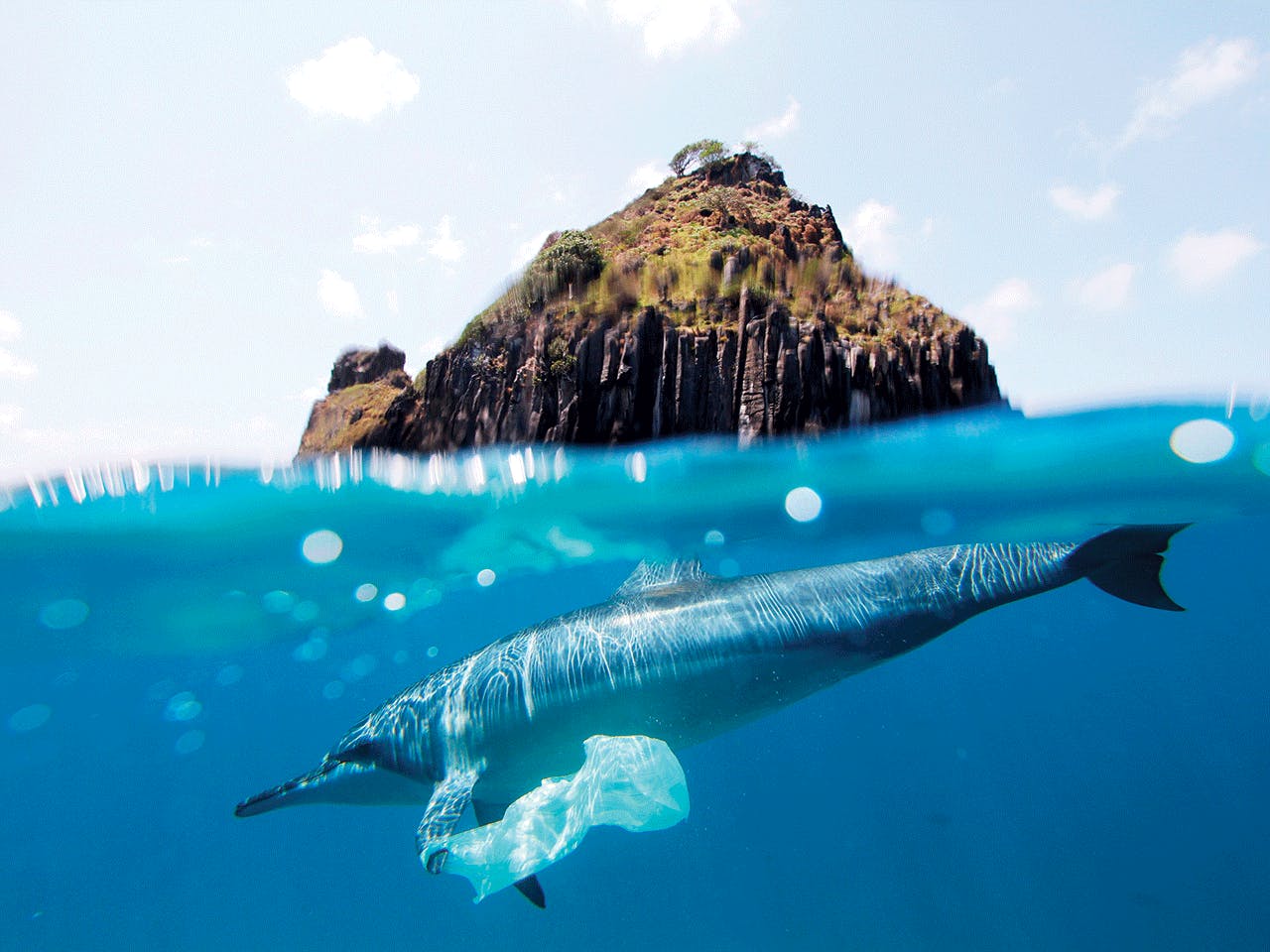The rainy season in Indonesia, which lasts from November to April, brings more than relief from the heat. Those heavy downpours also wash loads of plastic waste across Southeast Asia, said Mike O’Leary, founder of the environmental nonprofit R.O.L.E. Foundation in Bali. The plastic comes from inland and gets washed into the ocean, where some drifts down to northern Australia and perhaps even farther south. But most of it actually sinks, he said: “I wouldn’t like to see the sea floor around here.”
Once the rains end, the hot tropical sun dries the plastic and breaks it up into tiny pieces. The problem has gotten so bad that the island of Bali announced a “garbage emergency” earlier this year.
Tropical beaches covered in plastic garbage, dead whales with stomachs full of plastic trash, and sea turtles mistaking plastic bags for their preferred jellyfish prey have garnered much attention recently, as we come to realize how much plastic we use and waste.
But all that plastic waste in the ocean comes from somewhere, and most of it isn’t from marine activities. It’s from freshwater and terrestrial sources—from landfills, litter, vehicles, and clothing, to name but a few origins. Researchers are beginning to look at the waste’s travel habits, working backwards to figure out what needs to be done to turn that tide heading to the sea.
Synthetic plastic made for the consumer market began in the 1930s, but it was really after World War II that plastics became ubiquitous. The plastic shopping bag, for instance, only began to replace paper grocery bags in the 1980s in the United States. In a mere 30 years, give or take, they’ve become a major source of plastic pollution. Research by the International Union for the Conservation of Nature (IUCN) found that every person on the planet is basically dumping 43 plastic bags into the ocean each year. That’s an average, though, with significant regional differences; North Americans’ love of disposable products means they’re each throwing 150 bags into the sea annually.
As of 2015, we’ve created a total of 7 billion tons of plastic waste, and of that, only 9 percent was recycled—79 percent went to either landfills or into the broader environment, and the rest, 12 percent, was incinerated. Those numbers, estimated in a 2017 article published in Science Advances, reflect our terrible global recycling rates. According to the World Economic Forum, European countries recycle 30 percent of their plastic waste; the United States recycles only 9 percent.
Plastic use has mushroomed because it’s durable, inexpensive, and versatile, said Carl Gustaf Lundin, director of the IUCN Global Marine and Polar Programme in Gland, Switzerland. But now we’re paying the price for its use. “There are clearly lots of downsides we weren’t aware of—or didn’t want to know about—and they’re now starting to catch up with us,” he said.
“Researchers are beginning to look at the waste’s travel habits.”
Plastics break down into microplastics—fragments less than 5 millimeters long (even smaller pieces are sometimes referred to as “nanoplastics”). Most plastic doesn’t biodegrade because it’s created from propylene, a petroleum chemical made of a chain of carbon bonds that microorganisms (the ones that will chew through plants and animals) don’t recognize as a meal. This also accounts for the strength and long lifespan of most plastics, and why it’s so difficult to create a plastic that can be useful for years but also biodegrade.
At this point, plastic waste has been found everywhere, from Arctic Sea ice to Lake Hovsgol, near the northern Mongolian border, to deep-sea trenches in the Pacific Ocean. There’s no place left on Earth we could consider entirely plastic-free.
Freshwater systems are sensitive to microplastics because they’re often close to sources of waste, like landfills. We don’t know the extent of microplastics’ presence in fresh water and land, and how exactly they travel from one to the other, how and why they move, the degree to which they’re affecting aquatic life, or their effects on food systems. We are only at the very beginning of understanding the extent to which plastics are infiltrating and changing the environment.
Dafne Eerkes-Medrano, zooplankton ecologist at the Ecology and Conservation Group of Marine Scotland, was curious about where ocean plastics were coming from. Now that we know plastic waste isn’t just the obvious discarded water bottle but also tiny fragments we can’t see, there are even more questions about what happens to plastic the smaller it gets. One of the first things to understand is what happens to plastics when they’re released into the environment. Eerkes-Medrano maintains that plastic waste rubbish in the environment starts to degrade with UV radiation, with chemical degradation and with mechanical degradation. She suspects that plastics in oceans got attention first because they’re easier to notice. “Maybe we’ve become more accustomed to litter in fresh waters,” she said.
These microplastics’ life cycles are difficult to assess because there are so many factors involved, like weather and the type of plastic, and concentrations in surface water, said Scott Lambert, researcher with the Department of Aquatic Ecotoxicology at Goethe University Frankfurt and coeditor of a new book on microplastics in fresh water. “If you’ve got quite a large lake inflow and outflow isn’t so great,” he said, “once plastic is buried in sediments, it’s probably going to stay there for quite some time.”
Until recently, it was thought that plastic waste was primarily the result of bad waste management practices and spillage of product during transport. But a report from the IUCN, Primary Microplastics in the Ocean: A Global Evaluation of Sources, shows that 98 percent of primary microplastic waste is from “land-based activities” (“primary” is the plastic waste that’s the result of use; “secondary” is the smaller pieces of plastic that come from larger pieces of primary plastics breaking down in the environment). The two largest sources are textiles and transportation. Synthetic fibers in clothing fragment during washing and go down the drain with the used laundry water, entering the water stream. Transportation waste comes from tires and roads. Tires (no longer just rubber but also a mixture of synthetic polymers) disintegrate due to use, and then the plastic particles either get washed into the water streams when it rains, or the “dust” gets blown away. Another source of waste is the paint used to mark roads—a commonly used epoxy contains plastic, and after it gets worn off it enters freshwater systems.
Another study, published in Science, modeled how much waste in the oceans comes from populations living on coastlines by focusing on mismanaged plastic waste. The study’s authors looked at coastal regions with at least 100 inhabitants within 50 kilometers (30 miles) of a coast, and then modeled the amount of annual waste from these populations, how much of that is plastics, and how much of that plastic waste is mismanaged and is likely to make its way to the ocean. The top three countries for mismanaged plastic waste estimates that fit this pattern were China (an upper middle-income country, by the World Bank’s definition) and Indonesia and the Philippines (both lower middle-income countries). The only high-income economy on the list was the United States, which ranked 20th, right after North Korea.
Lundin at the IUCN notes that plastic waste has been largely ignored by most companies producing it. “No industry wants to put a lot of research into finding a new solution if they’re okay with just using what they’ve been selling all along,” he said.
For the textile industry, it’s a sad fact that recycling plastics into fabrics was thought to be a good way to deal with waste—until we found out that those recycled plastics are shedding into the environment. And there’s the added challenge of reeducating consumers who thought they were making environmentally sound purchases. Given the amount of microplastics such fabrics release into the environment, we’d probably be better off just throwing them in the trash. “It turns out they lose more plastic than practically any other type of clothing, and the fibers are falling off left, right, and center from these things,” said Lundin. “It’s probably the worst thing we could do in terms of getting plastics into nature.”
The tire industry, continued Lundin, will need to either replace the polymers commonly used with rubber, or use less-harmful polymers. But he doesn’t think this will happen without a significant degree of both societal pressure and regulation. “Right now the industry is sort of coming out of the denial phase where they say, ‘We don’t have a problem,’ to ‘We might have problem but there’s no obvious solution to it.’”
Consumer decisions and behaviors, like improving recycling rates, are only part of the solution, and maybe a small one at that. Lundin thinks product redesign will have the biggest impact and nip microplastic waste in the bud. He explains, “It’s more of a question of redesigning products so you won’t have this leakage of plastic when you use it the way it was intended to be used.”
The ecotoxicologist Scott Lambert adds that consumers might have incorrect ideas about biodegradable plastics. Most of them only degrade under specific circumstances, for instance when taken to industrial composting facilities, where the temperature is much higher than would ever be found in a typical backyard compost heap. “People have this image in their head that this plastic bag is biodegradable, so if it blows off it doesn’t matter,” he said.

More and more plastics are found in marine life, including the fish and shellfish that people eat, resulting in an increasing focus on their potential effects on human health. As plastics break down into smaller and smaller pieces, they’re able to pass through biological membranes. We also know that harmful metals and chemicals, including lead and cadmium, can attach to plastics. Eerkes-Medrano points out that what we don’t know the degree to which animals and humans absorb those metals when they ingest plastics, and, if so, their potential health effects. The question is, “When we eat plastic-infused shellfish, do we absorb any toxins the plastics are carrying?”
Despite these potentially alarming problems, Lambert says it’s too soon to panic about plastics and human health. For one thing, our exposure from sources like tap water is minimal. And you’d have to eat a whole lot of mussels for a significant amount of plastics to end up in your body.
So what are the solutions? We could use less plastics, clean up what’s already out there, and figure out ways to improve plastic recycling. As the world awakens to its plastic problem, there has been a surge in ideas to minimize, replace and reuse plastics, including anti-plastic-straw movements, McDonald’s announcing sustainable packaging goals, and melting plastics into fuels.
“It’s probably the worst thing we could do in terms of getting plastics into nature.”
But Lundin also thinks that eventually nature will take care of itself, thanks to evolution, and there will be microorganisms that consume plastic. He also thinks that could take a long time: “That’s going to take decades, centuries, millennia, depending where the plastic ends up, its composition, and if it has toxins.”
We might not have to wait that long. Researchers at the University of Portsmouth in the United Kingdom modified a plastic-munching enzyme first discovered in 2016 in Japan and discovered that its ability to process plastic improved. It began to break down the plastic used for disposable drink bottles in only days.
Doug Woodring, founder of Ocean Recovery, an environmental nonprofit based in Hong Kong, is a vocal proponent of plastics-to-fuel technology, which melts plastics down into usable fuel, particularly diesel. For regions of the world with a large amount of waste that rely on diesel, this technology could be a game changer. “We might as well make the diesel out of something that is a social problem—that is, trash—rather than sucking virgin diesel out of ground,” he said.
The truth is that much plastic doesn’t get recycled— either by governments or informal economies of trash pickers—because there’s no market for it. Woodring thinks that’s the plastic we should focus on. He said, “All the world’s garbage that is not easily recyclable, like candy wrappers, that is what we have to find uses for.”
However, there are supply chain problems that must be fixed first. The waste needs to be collected, sorted, and processed, and the only way that’s going to happen is for people to be paid to do it. This will need investment and long-term thinking, and because we don’t put a cost on garbage and mismanaged waste and its tangential results, like health problems, financing is hard to come by.
In Bali, Mike O’Leary’s R.O.L.E. is hoping education will help fix that island’s trash problem—only 25 percent of its waste is collected by municipal garbage services. The rest is burned or dumped. “The idea [is] to build skills in communities for waste management,” O’Leary said. GIven the lack of reliable collection services, the better bet is putting the power into communities’ hands, with education programs that give them the tools to understand and deal with waste on their own.
Whatever the likely multiple solutions to plastic waste, the sheer volume of plastics now in the environment will be there for years, said Lambert. We need to figure out what kind of environmental future our plastics addiction has created. “They’ll continue to break down, while human activities continue adding more plastics,” he said. “So we really need to know what’s going on and how they affect environmental processes.”
Those dead whales with bellies full of plastic deserved better. Let’s hope they can serve as a metaphorical warning we can act on, rather than a harbinger of worse to come.











